Comprehensive Financial Ratio Analysis and Evaluation of Sunbay Sales
VerifiedAdded on 2021/06/14
|6
|1194
|146
Report
AI Summary
This report analyzes the financial performance of Sunbay Sales through a comprehensive ratio analysis. It evaluates and compares various financial ratios, including profitability ratios (return on assets, profit margin), efficiency ratios (assets turnover, times debtors turnover), liquidity ratios (current ratio, quick ratio), and capital structure ratios (debt to equity, debt ratio). The report provides an executive summary, discusses the limitations of ratio analysis, and offers recommendations for improvement, particularly focusing on optimizing resource utilization to enhance the current ratio. The analysis provides insights into Sunbay Sales' financial health and provides a basis for informed decision-making. The report concludes by summarizing the key findings and providing recommendations for improvement.

Report on Evaluation of Ratio
Ratios comparison and recommendations
01/May/2018
Sunbay Sales
Ratios comparison and recommendations
01/May/2018
Sunbay Sales
Paraphrase This Document
Need a fresh take? Get an instant paraphrase of this document with our AI Paraphraser
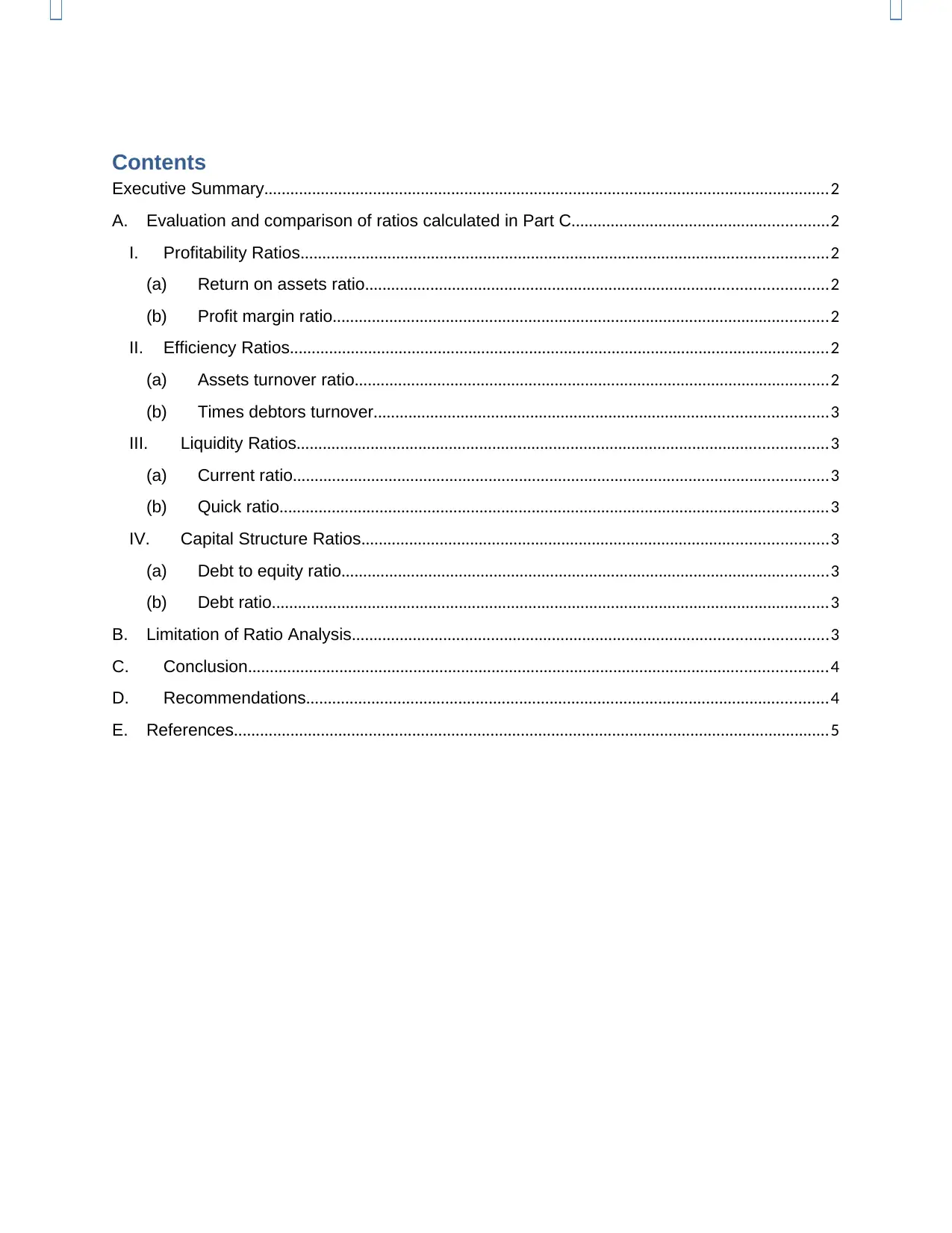
Contents
Executive Summary..................................................................................................................................2
A. Evaluation and comparison of ratios calculated in Part C...........................................................2
I. Profitability Ratios.........................................................................................................................2
(a) Return on assets ratio..........................................................................................................2
(b) Profit margin ratio..................................................................................................................2
II. Efficiency Ratios............................................................................................................................2
(a) Assets turnover ratio.............................................................................................................2
(b) Times debtors turnover........................................................................................................3
III. Liquidity Ratios..........................................................................................................................3
(a) Current ratio...........................................................................................................................3
(b) Quick ratio..............................................................................................................................3
IV. Capital Structure Ratios...........................................................................................................3
(a) Debt to equity ratio................................................................................................................3
(b) Debt ratio................................................................................................................................3
B. Limitation of Ratio Analysis.............................................................................................................3
C. Conclusion.....................................................................................................................................4
D. Recommendations........................................................................................................................4
E. References.........................................................................................................................................5
Executive Summary..................................................................................................................................2
A. Evaluation and comparison of ratios calculated in Part C...........................................................2
I. Profitability Ratios.........................................................................................................................2
(a) Return on assets ratio..........................................................................................................2
(b) Profit margin ratio..................................................................................................................2
II. Efficiency Ratios............................................................................................................................2
(a) Assets turnover ratio.............................................................................................................2
(b) Times debtors turnover........................................................................................................3
III. Liquidity Ratios..........................................................................................................................3
(a) Current ratio...........................................................................................................................3
(b) Quick ratio..............................................................................................................................3
IV. Capital Structure Ratios...........................................................................................................3
(a) Debt to equity ratio................................................................................................................3
(b) Debt ratio................................................................................................................................3
B. Limitation of Ratio Analysis.............................................................................................................3
C. Conclusion.....................................................................................................................................4
D. Recommendations........................................................................................................................4
E. References.........................................................................................................................................5
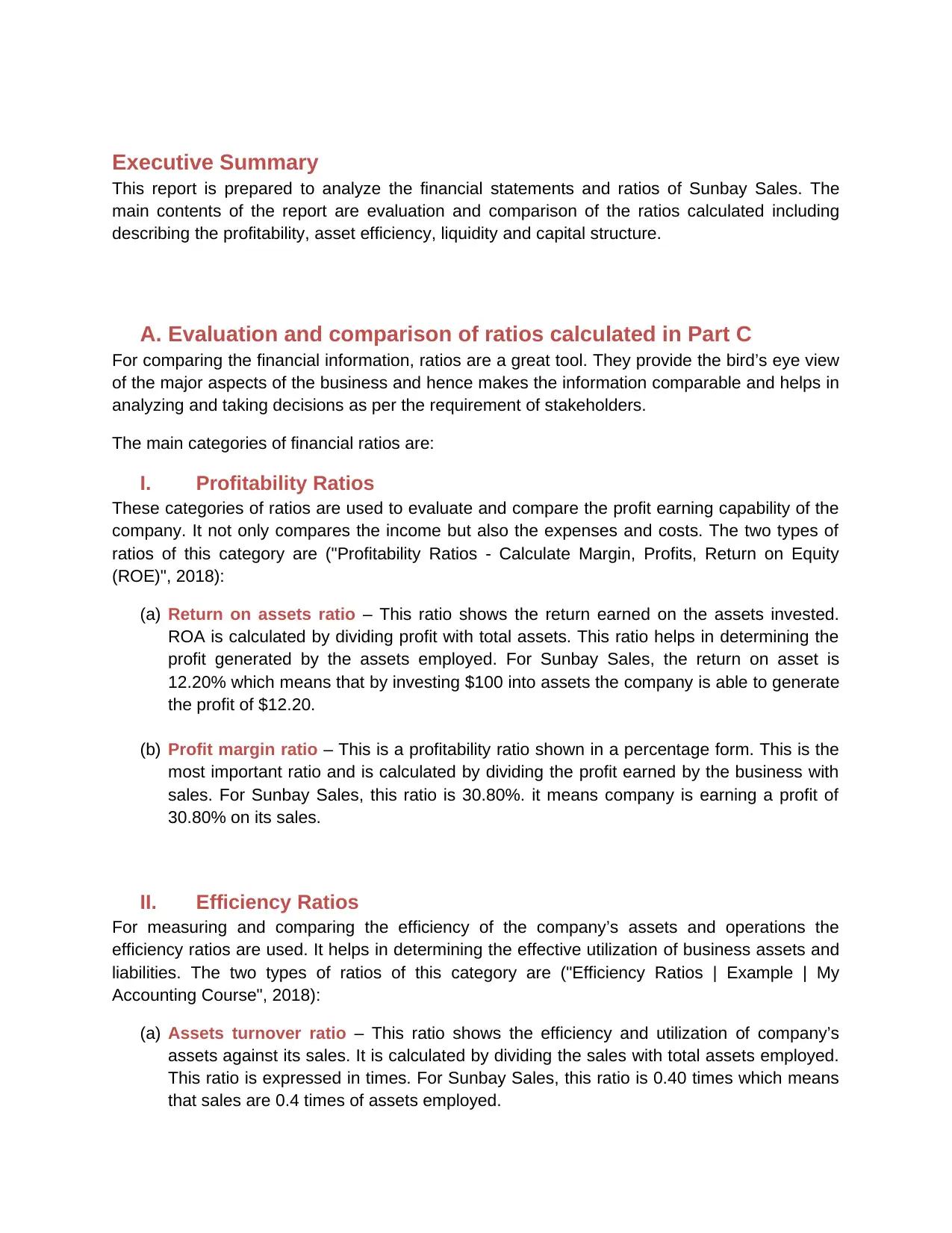
Executive Summary
This report is prepared to analyze the financial statements and ratios of Sunbay Sales. The
main contents of the report are evaluation and comparison of the ratios calculated including
describing the profitability, asset efficiency, liquidity and capital structure.
A. Evaluation and comparison of ratios calculated in Part C
For comparing the financial information, ratios are a great tool. They provide the bird’s eye view
of the major aspects of the business and hence makes the information comparable and helps in
analyzing and taking decisions as per the requirement of stakeholders.
The main categories of financial ratios are:
I. Profitability Ratios
These categories of ratios are used to evaluate and compare the profit earning capability of the
company. It not only compares the income but also the expenses and costs. The two types of
ratios of this category are ("Profitability Ratios - Calculate Margin, Profits, Return on Equity
(ROE)", 2018):
(a) Return on assets ratio – This ratio shows the return earned on the assets invested.
ROA is calculated by dividing profit with total assets. This ratio helps in determining the
profit generated by the assets employed. For Sunbay Sales, the return on asset is
12.20% which means that by investing $100 into assets the company is able to generate
the profit of $12.20.
(b) Profit margin ratio – This is a profitability ratio shown in a percentage form. This is the
most important ratio and is calculated by dividing the profit earned by the business with
sales. For Sunbay Sales, this ratio is 30.80%. it means company is earning a profit of
30.80% on its sales.
II. Efficiency Ratios
For measuring and comparing the efficiency of the company’s assets and operations the
efficiency ratios are used. It helps in determining the effective utilization of business assets and
liabilities. The two types of ratios of this category are ("Efficiency Ratios | Example | My
Accounting Course", 2018):
(a) Assets turnover ratio – This ratio shows the efficiency and utilization of company’s
assets against its sales. It is calculated by dividing the sales with total assets employed.
This ratio is expressed in times. For Sunbay Sales, this ratio is 0.40 times which means
that sales are 0.4 times of assets employed.
This report is prepared to analyze the financial statements and ratios of Sunbay Sales. The
main contents of the report are evaluation and comparison of the ratios calculated including
describing the profitability, asset efficiency, liquidity and capital structure.
A. Evaluation and comparison of ratios calculated in Part C
For comparing the financial information, ratios are a great tool. They provide the bird’s eye view
of the major aspects of the business and hence makes the information comparable and helps in
analyzing and taking decisions as per the requirement of stakeholders.
The main categories of financial ratios are:
I. Profitability Ratios
These categories of ratios are used to evaluate and compare the profit earning capability of the
company. It not only compares the income but also the expenses and costs. The two types of
ratios of this category are ("Profitability Ratios - Calculate Margin, Profits, Return on Equity
(ROE)", 2018):
(a) Return on assets ratio – This ratio shows the return earned on the assets invested.
ROA is calculated by dividing profit with total assets. This ratio helps in determining the
profit generated by the assets employed. For Sunbay Sales, the return on asset is
12.20% which means that by investing $100 into assets the company is able to generate
the profit of $12.20.
(b) Profit margin ratio – This is a profitability ratio shown in a percentage form. This is the
most important ratio and is calculated by dividing the profit earned by the business with
sales. For Sunbay Sales, this ratio is 30.80%. it means company is earning a profit of
30.80% on its sales.
II. Efficiency Ratios
For measuring and comparing the efficiency of the company’s assets and operations the
efficiency ratios are used. It helps in determining the effective utilization of business assets and
liabilities. The two types of ratios of this category are ("Efficiency Ratios | Example | My
Accounting Course", 2018):
(a) Assets turnover ratio – This ratio shows the efficiency and utilization of company’s
assets against its sales. It is calculated by dividing the sales with total assets employed.
This ratio is expressed in times. For Sunbay Sales, this ratio is 0.40 times which means
that sales are 0.4 times of assets employed.
⊘ This is a preview!⊘
Do you want full access?
Subscribe today to unlock all pages.

Trusted by 1+ million students worldwide
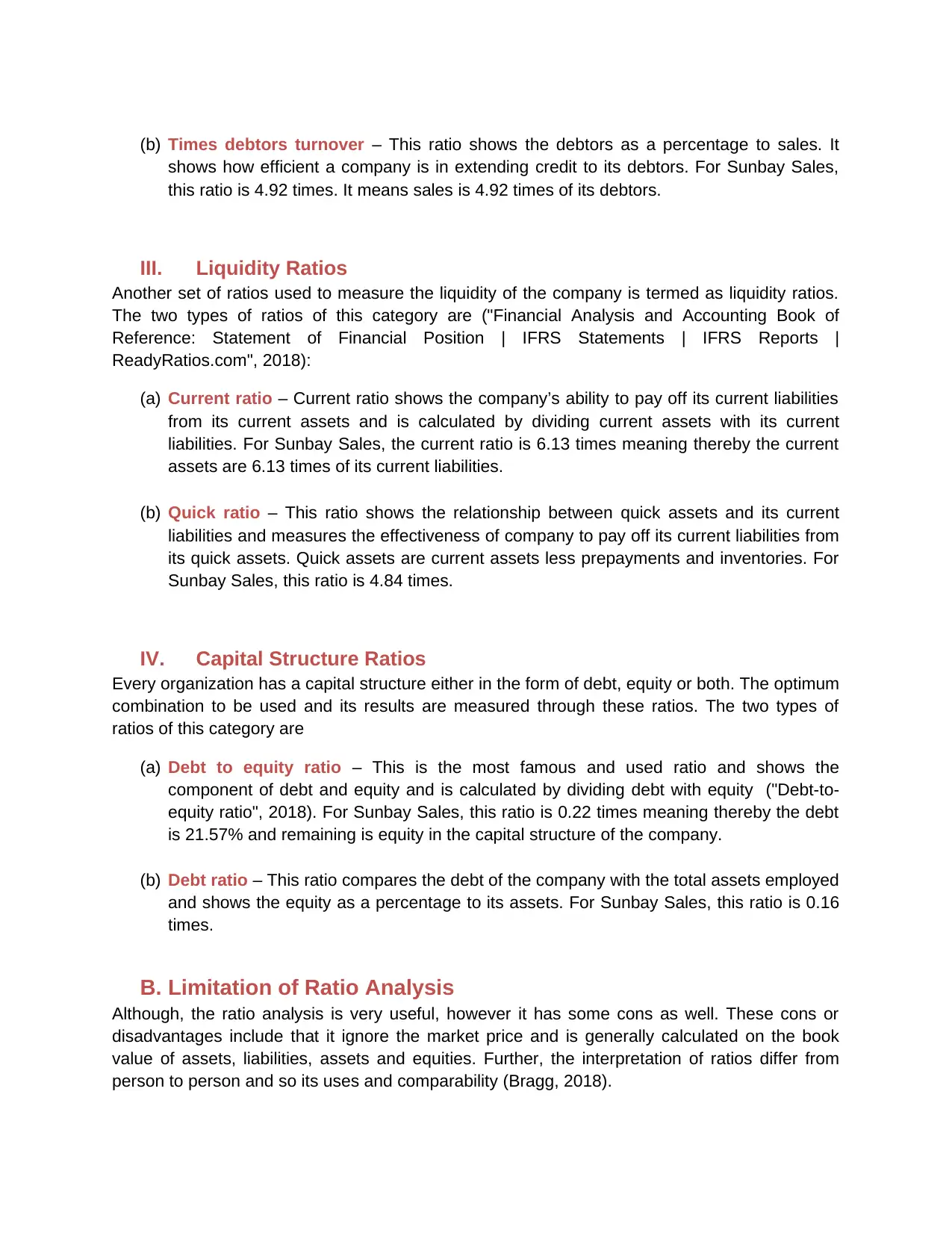
(b) Times debtors turnover – This ratio shows the debtors as a percentage to sales. It
shows how efficient a company is in extending credit to its debtors. For Sunbay Sales,
this ratio is 4.92 times. It means sales is 4.92 times of its debtors.
III. Liquidity Ratios
Another set of ratios used to measure the liquidity of the company is termed as liquidity ratios.
The two types of ratios of this category are ("Financial Analysis and Accounting Book of
Reference: Statement of Financial Position | IFRS Statements | IFRS Reports |
ReadyRatios.com", 2018):
(a) Current ratio – Current ratio shows the company’s ability to pay off its current liabilities
from its current assets and is calculated by dividing current assets with its current
liabilities. For Sunbay Sales, the current ratio is 6.13 times meaning thereby the current
assets are 6.13 times of its current liabilities.
(b) Quick ratio – This ratio shows the relationship between quick assets and its current
liabilities and measures the effectiveness of company to pay off its current liabilities from
its quick assets. Quick assets are current assets less prepayments and inventories. For
Sunbay Sales, this ratio is 4.84 times.
IV. Capital Structure Ratios
Every organization has a capital structure either in the form of debt, equity or both. The optimum
combination to be used and its results are measured through these ratios. The two types of
ratios of this category are
(a) Debt to equity ratio – This is the most famous and used ratio and shows the
component of debt and equity and is calculated by dividing debt with equity ("Debt-to-
equity ratio", 2018). For Sunbay Sales, this ratio is 0.22 times meaning thereby the debt
is 21.57% and remaining is equity in the capital structure of the company.
(b) Debt ratio – This ratio compares the debt of the company with the total assets employed
and shows the equity as a percentage to its assets. For Sunbay Sales, this ratio is 0.16
times.
B. Limitation of Ratio Analysis
Although, the ratio analysis is very useful, however it has some cons as well. These cons or
disadvantages include that it ignore the market price and is generally calculated on the book
value of assets, liabilities, assets and equities. Further, the interpretation of ratios differ from
person to person and so its uses and comparability (Bragg, 2018).
shows how efficient a company is in extending credit to its debtors. For Sunbay Sales,
this ratio is 4.92 times. It means sales is 4.92 times of its debtors.
III. Liquidity Ratios
Another set of ratios used to measure the liquidity of the company is termed as liquidity ratios.
The two types of ratios of this category are ("Financial Analysis and Accounting Book of
Reference: Statement of Financial Position | IFRS Statements | IFRS Reports |
ReadyRatios.com", 2018):
(a) Current ratio – Current ratio shows the company’s ability to pay off its current liabilities
from its current assets and is calculated by dividing current assets with its current
liabilities. For Sunbay Sales, the current ratio is 6.13 times meaning thereby the current
assets are 6.13 times of its current liabilities.
(b) Quick ratio – This ratio shows the relationship between quick assets and its current
liabilities and measures the effectiveness of company to pay off its current liabilities from
its quick assets. Quick assets are current assets less prepayments and inventories. For
Sunbay Sales, this ratio is 4.84 times.
IV. Capital Structure Ratios
Every organization has a capital structure either in the form of debt, equity or both. The optimum
combination to be used and its results are measured through these ratios. The two types of
ratios of this category are
(a) Debt to equity ratio – This is the most famous and used ratio and shows the
component of debt and equity and is calculated by dividing debt with equity ("Debt-to-
equity ratio", 2018). For Sunbay Sales, this ratio is 0.22 times meaning thereby the debt
is 21.57% and remaining is equity in the capital structure of the company.
(b) Debt ratio – This ratio compares the debt of the company with the total assets employed
and shows the equity as a percentage to its assets. For Sunbay Sales, this ratio is 0.16
times.
B. Limitation of Ratio Analysis
Although, the ratio analysis is very useful, however it has some cons as well. These cons or
disadvantages include that it ignore the market price and is generally calculated on the book
value of assets, liabilities, assets and equities. Further, the interpretation of ratios differ from
person to person and so its uses and comparability (Bragg, 2018).
Paraphrase This Document
Need a fresh take? Get an instant paraphrase of this document with our AI Paraphraser
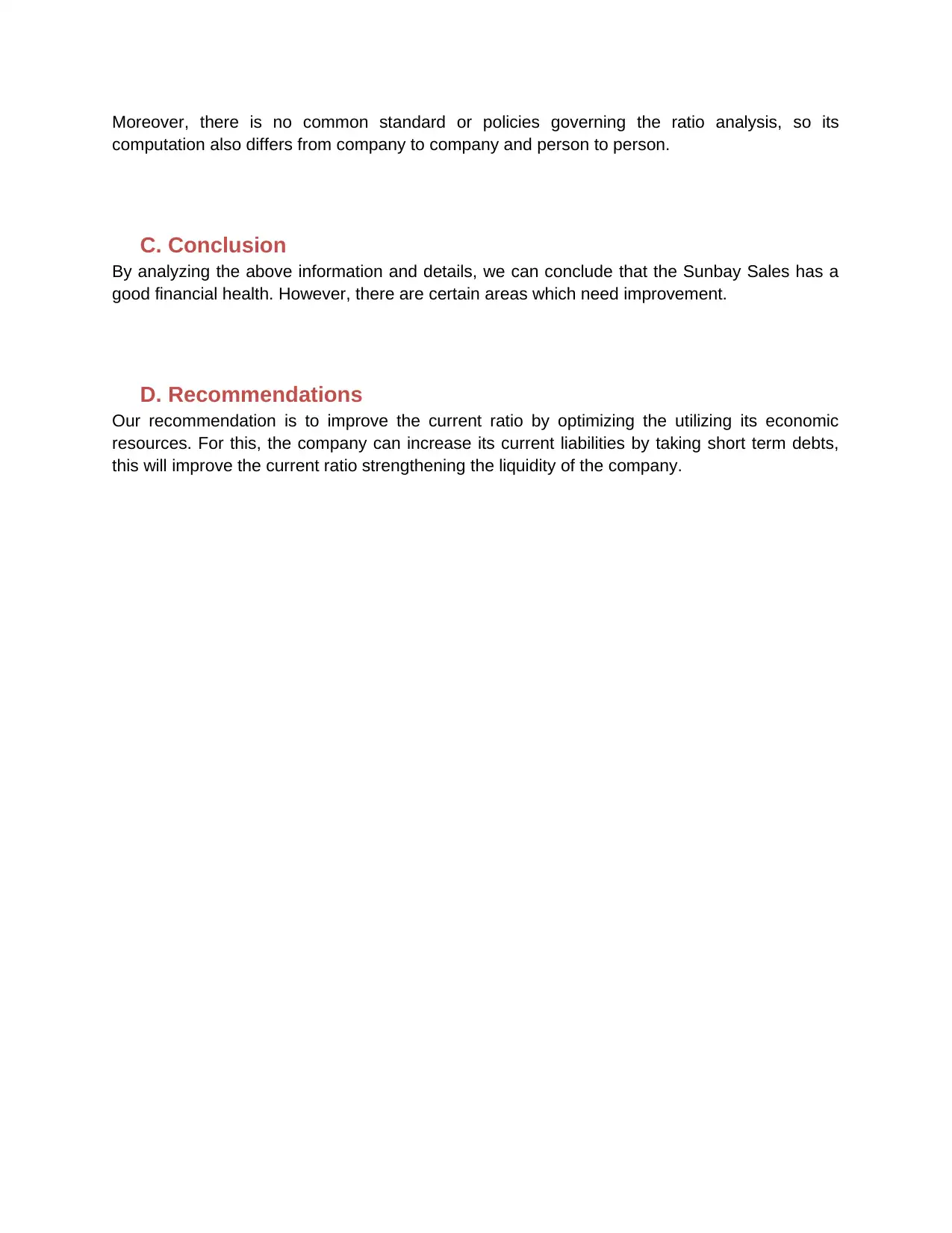
Moreover, there is no common standard or policies governing the ratio analysis, so its
computation also differs from company to company and person to person.
C. Conclusion
By analyzing the above information and details, we can conclude that the Sunbay Sales has a
good financial health. However, there are certain areas which need improvement.
D. Recommendations
Our recommendation is to improve the current ratio by optimizing the utilizing its economic
resources. For this, the company can increase its current liabilities by taking short term debts,
this will improve the current ratio strengthening the liquidity of the company.
computation also differs from company to company and person to person.
C. Conclusion
By analyzing the above information and details, we can conclude that the Sunbay Sales has a
good financial health. However, there are certain areas which need improvement.
D. Recommendations
Our recommendation is to improve the current ratio by optimizing the utilizing its economic
resources. For this, the company can increase its current liabilities by taking short term debts,
this will improve the current ratio strengthening the liquidity of the company.
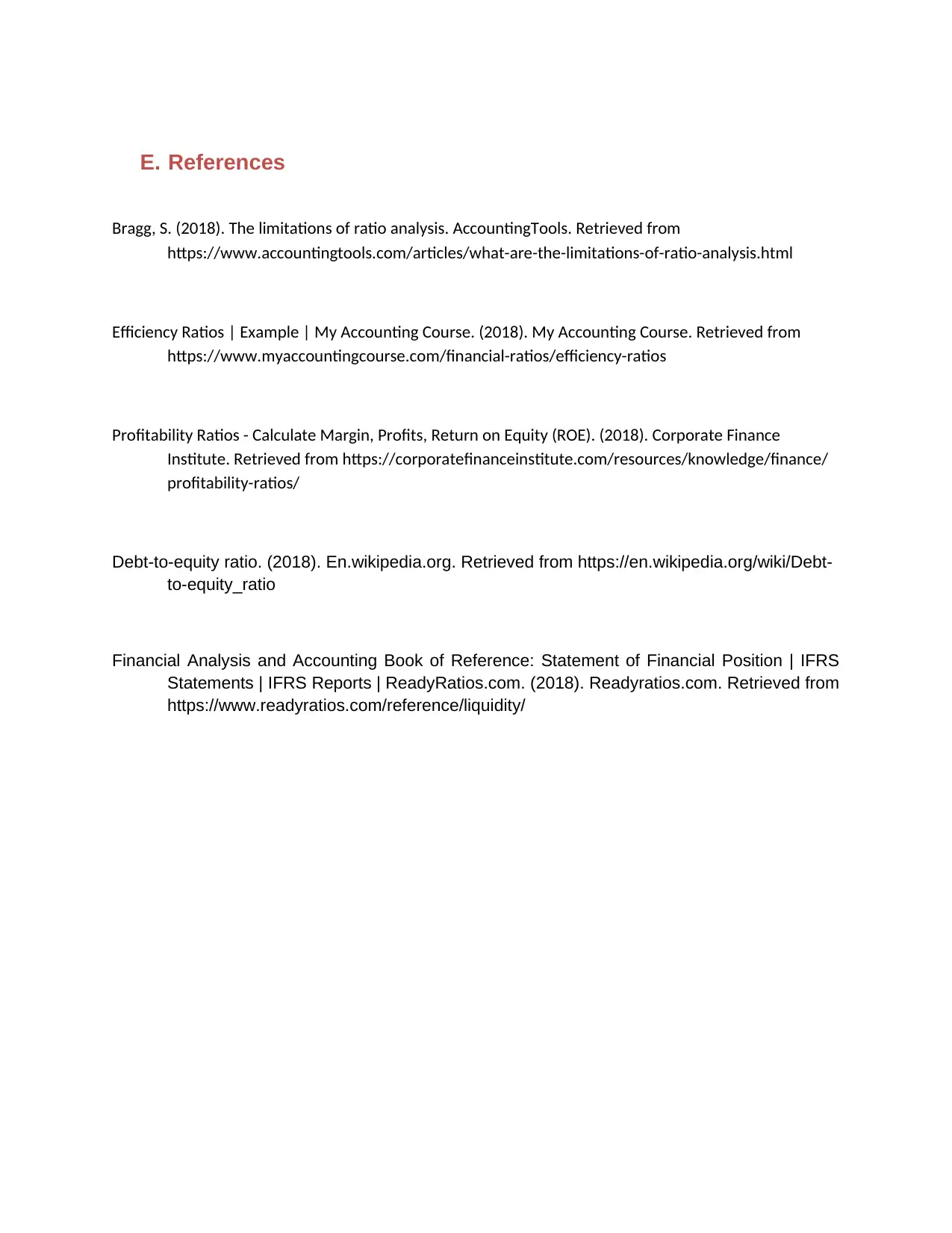
E. References
Bragg, S. (2018). The limitations of ratio analysis. AccountingTools. Retrieved from
https://www.accountingtools.com/articles/what-are-the-limitations-of-ratio-analysis.html
Efficiency Ratios | Example | My Accounting Course. (2018). My Accounting Course. Retrieved from
https://www.myaccountingcourse.com/financial-ratios/efficiency-ratios
Profitability Ratios - Calculate Margin, Profits, Return on Equity (ROE). (2018). Corporate Finance
Institute. Retrieved from https://corporatefinanceinstitute.com/resources/knowledge/finance/
profitability-ratios/
Debt-to-equity ratio. (2018). En.wikipedia.org. Retrieved from https://en.wikipedia.org/wiki/Debt-
to-equity_ratio
Financial Analysis and Accounting Book of Reference: Statement of Financial Position | IFRS
Statements | IFRS Reports | ReadyRatios.com. (2018). Readyratios.com. Retrieved from
https://www.readyratios.com/reference/liquidity/
Bragg, S. (2018). The limitations of ratio analysis. AccountingTools. Retrieved from
https://www.accountingtools.com/articles/what-are-the-limitations-of-ratio-analysis.html
Efficiency Ratios | Example | My Accounting Course. (2018). My Accounting Course. Retrieved from
https://www.myaccountingcourse.com/financial-ratios/efficiency-ratios
Profitability Ratios - Calculate Margin, Profits, Return on Equity (ROE). (2018). Corporate Finance
Institute. Retrieved from https://corporatefinanceinstitute.com/resources/knowledge/finance/
profitability-ratios/
Debt-to-equity ratio. (2018). En.wikipedia.org. Retrieved from https://en.wikipedia.org/wiki/Debt-
to-equity_ratio
Financial Analysis and Accounting Book of Reference: Statement of Financial Position | IFRS
Statements | IFRS Reports | ReadyRatios.com. (2018). Readyratios.com. Retrieved from
https://www.readyratios.com/reference/liquidity/
⊘ This is a preview!⊘
Do you want full access?
Subscribe today to unlock all pages.

Trusted by 1+ million students worldwide
1 out of 6
Related Documents
Your All-in-One AI-Powered Toolkit for Academic Success.
+13062052269
info@desklib.com
Available 24*7 on WhatsApp / Email
![[object Object]](/_next/static/media/star-bottom.7253800d.svg)
Unlock your academic potential
Copyright © 2020–2025 A2Z Services. All Rights Reserved. Developed and managed by ZUCOL.





